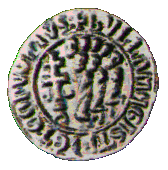http://www.lishfd.org/History/history_of_the_maltese_cross.htm Whilst the history of the Order has gained the attention of a good number of historians, there has been no real critical appraisal on when and how the eight-pointed Maltese Cross was introduced into the Order of St John of Jerusalem. This is a matter which has escaped the attentions of those otherwise respected as academics, who by failing to investigate this aspect, continue to allow myth to replace historical reality.
Defining what we mean by the "Maltese Cross". For the purposes of this article, the Maltese Cross is defined as;
"a cross of made from four straight lined pointed arrowheads , meeting at their points, with the ends of the arms consisting of indented 'v's". Given this description, no seal, painting, or drawing which concerns the Order, that is not anachronistic (i.e. produced later, to represent an earlier period), before the mid-late 1500s, portrays the now familiar eight pointed cross.
History questioned. Edwin J King raises the question of historical inaccuracies, commenting on an article by Alison Phillips in the Encyclopaedia Britannica, which states that the Maltese Cross was introduced at the inception of the Order. King writes "
I know not his authority for stating that the eight-pointed cross was adopted at so early a date. Canon Giraud in his Life of the Blessed Gerard states that in his day the Hospitallers used an ordinary Latin cross, and that Raymond du Puy introduced the eight-pointed cross, but gives no authority for his statement."
#1. Fortunately, King has provided further insights to the problem in his published research on the Seals of the Order, which provides examples of the various forms of the crosses used by the Order, throughout the centuries
#2.
The Cross on the original Great Seal of the Convent of St John in Jerusalem is the True Cross (depicted in image as a Patriarchal Cross), which adds an upper crossbar (inscription-plate)
#3. The arms of the cross are slightly fluted. The Patriarchal Cross may have been the initial form of Cross used by the Order. Some evidence of the first form of cross is given by Elias Ashmole writing about the Knights Templar in 1715; "
Their Habit was white, to which, in the time of Eugenius III they added the Red Cross, and of the same Form that the Hospitallers wore (Favin says a Patriarchal Cross) and sowed it on the left shoulder of the Maulles"
#4. The depiction of devotion to the True Cross, is also one found on coins of the Kingdom of Jerusalem, and may only have been an image to depict that the Order was "of Jerusalem".
The early use of a Cross. If the Patriarchal Cross was the first form of cross, then it soon gave way to an equally early form of cross used by the Order, that of the Cross Formée (a Greek Cross with fluted arms). This cross can be seen on the wall of the stairs leading to the chapel within the Krak des Chevaliers which was the Syrian Castle of the Hospitallers from 1144 to 1271.A good example of early forms of the cross are provided by the two seals of the Oxford Hospital circa 1234 and later. These are in the form of Cross Formée and Pattée Formée, both with Fitch at Foot (
fig. 2.)
#5. Other examples are to be found in King
#6.
fig. 2.
| fig. 1.
Great Seal of the Convent. |
Hier mal das Siegel von 1234 und eines von 1216 jeweils mit Kreuz.
























![XUANPAI Nordischer Wikinger Schmuck Nordisches Armband für Männer Schutzamulett Mobius Armreifen Valknut Vikinger Talisman Armband Geburtstagsgeschenk]](https://m.media-amazon.com/images/I/31tuQkMNiML._SL500_.jpg)




















